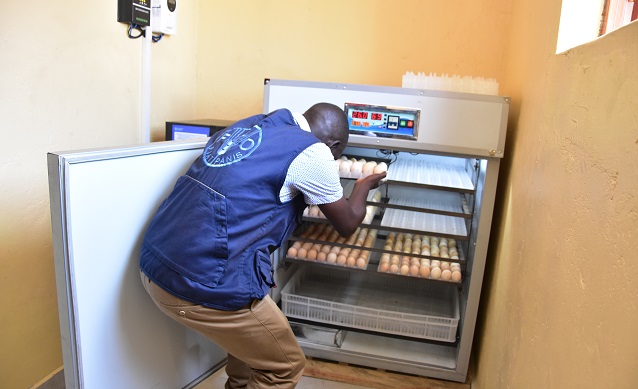
Katakwi, Uganda | Patricia Akankwatsa | The Food and Agriculture Organization of the United Nations (FAO) is making significant strides in improving poultry farming in the Teso sub-region of Uganda. Through a comprehensive initiative aimed at building climate resilience and ensuring food security for smallholder farming households, FAO is providing farmers with access to improved chicken breeds and essential resources.
The project involves the establishment of hatcheries in the Teso sub-region, where farmers can obtain high-quality chicks. These breeds are specifically selected for their superior growth rates, disease resistance, and adaptability to local conditions. By providing farmers with access to these improved breeds, the FAO is helping to increase poultry production and improve the livelihoods of local communities.
FAO country representative Dr. Antonio Querido, says that this project is in partnership with the National Agricultural Research Organisation (NARO), to improve the genetics of the local chicken and also, to create a way that enhances the production of chicken at the local level.
“These hatcheries have a capacity of producing over 15,000 birds a year. With this, we believe that we create the capacity to explore the potential that we see when it comes to the production of local chicken,”
He adds that these hatcheries create an opportunity for farmers to increase production because instead of waiting for the natural process of one chicken to hatch, they can take their eggs to the hatcheries every week.
“We hope that this model will help us to see how we scale up this intervention so that other communities can have the same,”
In addition to providing access to improved breeds, FAO is also offering training and technical assistance to farmers on poultry management practices. This includes guidance on feeding, vaccination, and disease prevention.
It has established farmer field schools in the Teso sub-region of Uganda, each comprising a group of 30 farmers. These schools serve as hubs for agricultural knowledge exchange and skill development, fostering a collaborative learning environment among participants.
Gladys Eluru Odia a member of the Omodoi United women’s farm field school says that through these trainings, they have learnt how to ratio birds.
“I have 65 birds but of all them, you can find like two cocks with the training from FAO, we will be able to ratio them 1:8 like we have been taught and be able to produce improved breeds which will gradually improve our income,”
She adds that the most pressing challenge has been diseases that attack the chicks which led to less production.
“FAO has taught us how to manage these diseases and with continued training, we will be able to manage and maintain high standards,”
By equipping farmers with the necessary skills and knowledge, FAO is empowering them to raise healthier and more productive poultry flocks.
Dr. Brian Babigumira from NARO emphasized the resilience of the improved Indigenous chickens distributed to farmers. He noted that these chickens are well-suited to local conditions, having been developed using Ugandan genetics.
“The genetics we’ve introduced are compatible with the local chicken population, ensuring no negative impact on the genetic diversity of the region,” he explained.
“These indigenous chickens have evolved over many years, adapting to the local environment. This has equipped them with traits that enable them to withstand disease challenges and maintain high survival rates,”
The initiative is expected to have a significant economic impact on the Teso sub-region. Increased poultry production can lead to higher incomes for smallholder farmers, as well as job creation in related industries. Moreover, the availability of affordable and nutritious poultry products can contribute to improved food security and nutrition for local communities.
FAO’s efforts to boost poultry farming in Teso are aligned with its broader goals of promoting sustainable agriculture and reducing hunger and malnutrition. By providing farmers with the tools and resources they need to succeed, FAO is helping to build a more resilient and prosperous future for the people of Uganda.
The two community hatcheries have been established in the Teso sub-region, one in Omodoi Cell, Ochero Town Council, Kaberamaido District, and the other in Katakwi Town Council, Katakwi District.
 The Independent Uganda: You get the Truth we Pay the Price
The Independent Uganda: You get the Truth we Pay the Price



